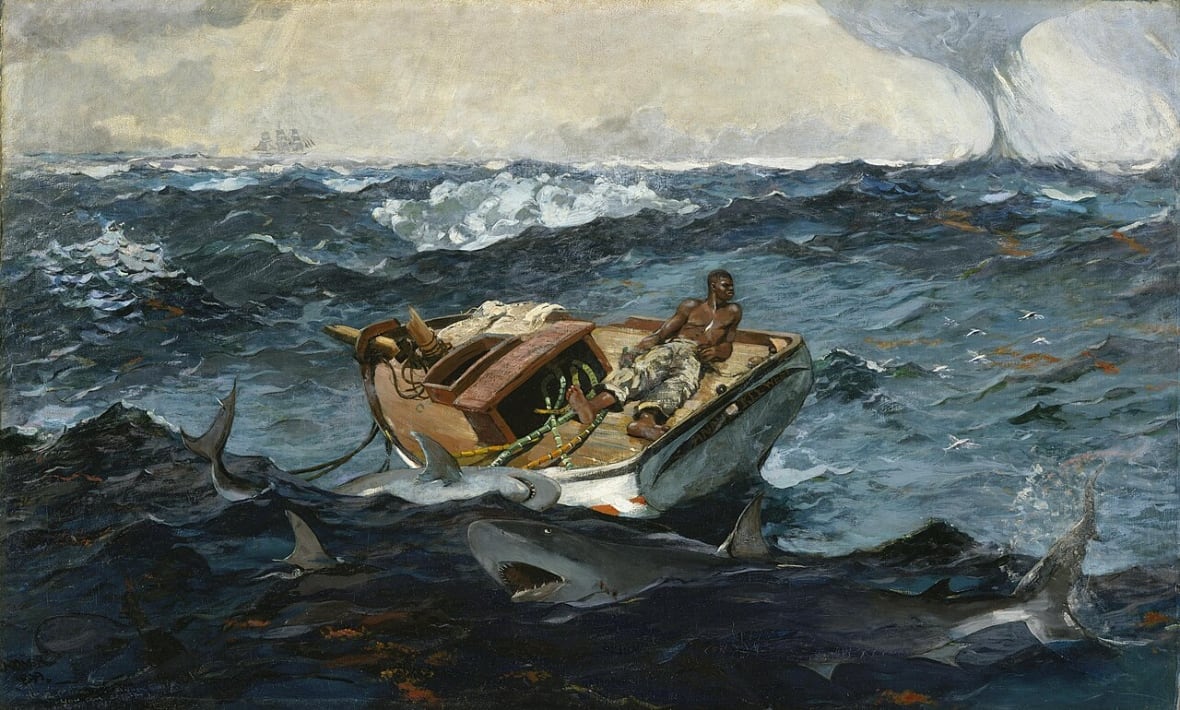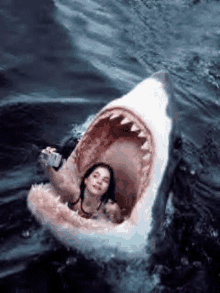
Posted on 06/24/2025 12:47:57 PM PDT by jerod
The classic 1975 film put sharks on our radar in a very real way
It was 50 years ago this month when Jaws premiered and instantly became a blockbuster hit. The film broke box office records and tapped into an underlying fear of sharks and the unknown lurking in the ocean.
Moviegoers in 1975 left the theatre thinking they learned a lesson: sharks are out to get humans.
The movie is fictional but it's conceivable a great white shark hungry enough would be dangerous around swimmers. Stories about these sharks have existed even before Jaws came out, yet fear has a way of winning over rational thinking and facts.
Michaela Thompson was seven when she watched Jaws on TV in the '80s without her parents knowing. She says it changed her life.
"I could not go in the bathtub because sharks were going to come through miles of plumbing, into the bathtub and eat me," Thompson, now a historian and anthropologist of science at MIT and Harvard University, said in the IDEAS documentary Jaws and an Ocean Full of Monsters.
As Jaws fans will point out, the moments of terror in the movie rarely feature the shark as it bullets out of the water. It can be more frightening when something wild and vicious is suggested.
"For the first two major attacks on humans that you see, you don't see the shark. You just see the person either getting pulled under dark water in the case of Chrissie Watkins or kind of disappearing in a spray of blood with regards to Alex Kintner," Thompson explained, referencing Susan Backlinie and Jeffrey Voorhees' ill-fated characters, respectively.
The fact that you don't see the shark for two thirds of the movie is partly due to some technical difficulties the crew had with their mechanical shark, nicknamed Bruce. To accommodate the constant malfunctions, director Steven Spielberg filmed many scenes with Bruce not appearing at all, instead suggesting the shark's presence.

When combined with composer John Williams' iconic score that alerted viewers when the shark was on the prowl, it became a brilliant way to create suspense and panic.
"Even though it is undeniably a shark, you can put whatever you want on this villain, because the villain is in some ways a void where you can place your fears," said Thompson.
The rogue shark theory
Jaws the film was based on Peter Benchley's 1974 novel of the same name. In it, he based the antagonist on what's called the rogue shark theory.
The idea is that there's a singular shark claiming its territory to hunt for its next meal, instead of a group of sharks living and hunting together.
"The whole point of Jaws is that it's just one shark. It's not any number of sharks. And so once you remove the rogue shark from the area, you've gotten rid of the bad shark, basically. Then the water is once again safe for people," Thompson said.
John Chisholm, an adjunct scientist at the New England Aquarium who studies sharks, says our impulse to peg the great white shark as a villain was created long before Jaws.
"It's like a primal innate fear, and [Jaws] just played upon that, and that's why the movie worked so well," he said, pointing to news reporting attacks in the U.S., Australia and South Africa, and sharks depicted in 19th-century paintings.
For Chisholm, when oceanographer Matt Hooper (played by Richard Dreyfuss) pulls a shark tooth out of the boat's hull, he immediately thought of stories he heard from his family in Prince Edward Island of sharks attacking dories going back as far as the late 19th century.

One of the most famous incidents involved a shark nicknamed the Forchu Rammer in 1953. It sunk a boat in the waters near Forchu, N.S., and one of the crew drowned, Chisholm said.
"The Forchu story appears in the in the February 1968 issue of National Geographic that Chief Brody flips through in the film," he said.
An ocean of dark mystery
To Peter Girguis, a professor of marine biology at Harvard, sharks are just one reason we fear the ocean's dark depths.
He teaches a course that explores the human relationship with the ocean and mythical sea monsters, from the kraken to the hydra.
"To me, sea monsters are in many ways a vehicle, if you will, for talking about our fears of the ocean," Girguis said.
"For a lot of people, the darkness of the ocean, being able to look down and not see the bottom, I think speaks to a real instinctual fear we have of the unknown."
To Chisholm, that darkness makes the ocean as wild a setting as the Amazon rainforest or the Serengeti.
"You can see a bear coming through the woods, and try to escape if it's coming after you," he said. "But when you're in the water — and people, I think all too often take for granted that the water is like their personal pool — it's really a wilderness area."
Time for a makeover?
In the 21st century, Michaela Thompson says we are continually re-imagining the shark for ourselves.
"They've kind of been recast as heroes, almost as critical and ecological actors," she said.
According to the International Shark Attack File published by the Florida Museum, there were 47 known, unprovoked shark attacks in 2024 around the world. Four of those attacks were fatal, which is consistent with the yearly average.
In 2019, humans killed more than 100 million sharks — intentionally and unintentionally —from fishing.
Sport fishermen saw white sharks as worthy opponents. And in the aftermath of Jaws, suddenly these sharks became highly fetishized," Thompson said.
But Chisholm said the movie did have a positive impact, too.
"It inspired a lot of young people to grow up and be shark biologists like me."


Bull Sharks on the other hand......
They have a face only a mother shark could love.
Uh huh. Still no go for me.
Bull sharks are the worst. Mean and can swim into freshwater.
Over 50% of shark attacks are Bull Sharks.
Mr. Vaughn, what we are dealing with here is a perfect engine, an eating machine. It’s really a miracle of evolution. All this machine does is swim and eat and make little sharks, and that’s all.
I’m sure those sharks who ate the men floating in the water after the USS Indianapolis was torpedoed in 1945 never thought sharks were “fetishized”.
In WWII, there were plenty of incidents besides the USS Indianapolis that got no publicity at all. When the USS Wasp was sunk in September 1942, many men were attacked by sharks and gruesomely torn to pieces in full view of men on ships who were unable to save them. They were forced to watch this terrible spectacle until the sun finally set and covered the scene with darkness.
When we are in control of ourselves and the elements we find ourselves in, we are the top of the chain. When we are not in control, we become prey.
There is a reason wolves were hunted to near extinction in many places, and it wasn’t solely because they were attacking livestock. Same with sharks.
Yeah cool story that great white sharks aren’t really villains. Take a nice leisurely swim 500 yards off the beach in Martha’s Vineyard… Or along the great barrier reef, or in Sydney Bay, orb The Farallon Islands…. Get back to me if you live.
This is right up there with those females who are always lecturing us about how rattlesnakes are beautiful animals
The shark population needs to be reduced.
Except that it was inspired by actual events: the Jersey Shore shark attacks of 1916.
I was 14 when my own MOTHER handed me her copy of, ‘Jaws’ and said, ‘You have GOT to read this!’
Then, I was dumb enough a year later to sneak into the theater at age 15 to see the movie. It was the first R-rated movie I had ever seen.
Dumbest thing I have ever done to myself! *SHUDDER*
They are!
At least rattlesnakes don’t chase you, unlike wolves and pumas and mooses. (A moose once but my sister.)
We have a horror of being eaten.
A white shark attacks and kills you because he mistakes you for a seal. A bull shark attacks you and bites off your leg because he wants to eat it. He doesn’t care what you are. A tiger shark knows you are a human, and kills you in order to eat you.
So what? With all three, you’re dead.
Fond memories of seeing this film for the first time in a theater in 1975 when I was 25.
Iirc, there was some theory being discussed many years ago that for certain larger shark species common to the Yellow Sea and Western Pacific areas, especially tiger sharks, became somewhat conditioned by naval warfare battles and ship sinkings during WW2. Show up at a ship sinking and catch a snack.
Disclaimer: Opinions posted on Free Republic are those of the individual posters and do not necessarily represent the opinion of Free Republic or its management. All materials posted herein are protected by copyright law and the exemption for fair use of copyrighted works.